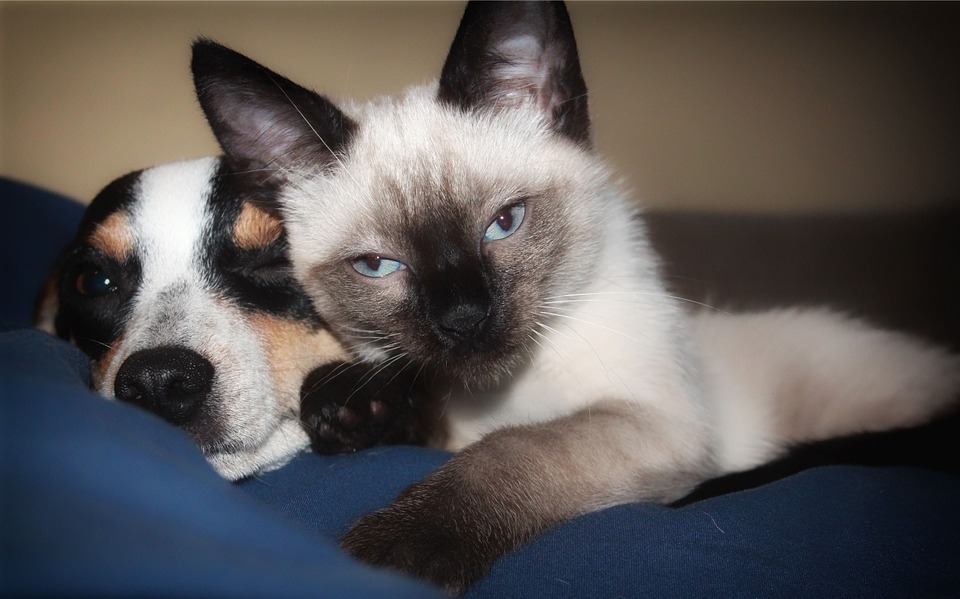Animal behaviour scientists from the University of Lincoln, UK, have discovered that filling your home with appeasing pheromones could be the key to a happy household where both dogs and cats are living under the same roof.
The new research, led by Professor Daniel Mills and Dr Miriam Prior, explored the effects of two different pheromone products on cat-dog interactions in homes where owners could see room for improvement in their pets’ relationships.
Their new scientific paper is now available to read online via the journal Frontiers in Veterinary Science.
The results show that both products used — Feliway Friends, which emits pheromones that are calming for cats, and Adaptil, which does the same for dogs — both had a positive impact on the interactions between cats and dogs living in the same home.
Over a six week period, both products led to a notable decrease in undesirable interactions — such as dog chasing cat, cat hiding from dog, cat and dog staring at each other, and dog barking at cat. Users of Adaptil even observed a significant increase in some desirable behaviours — friendly greetings between cat and dog, and time spent relaxing in the same room.
“Although we are all aware of the perceived tensions between cats and dogs, we believe this is the first study of its kind to explore the use of pheromone products to improve the relationship when the two species are living in the same household,” explained Professor Mills, Professor of Veterinary Behavioural Medicine in Lincoln’s School of Life Sciences.
“Seven per cent of households in the UK own both a cat and a dog, which represents a large number of pet owners and their animals living with potentially stressful animal relationships on a day-to-day basis. Many cat and dog owners report that their animals are comfortable in each other’s’ company, but where this isn’t the case, a poor relationship between a resident cat and dog can have serious consequences for the welfare of individual animals. There may be an unacceptable level of social stress or restricted access to key resources such as food, water or suitable toilet areas. There will also be increased stress for the remainder of the family (both human and animal), and potential risks of injury due to conflict.”
It has also been reported that a problematic relationship between a new pet and an existing pet is one of the main reasons for cats and dogs being taken to shelters for rehoming.
The pet owners involved in this new scientific trial reported weekly on the frequency of 10 specific undesirable interactions and seven specific desirable interactions between their cats and dogs. They were split into two groups; one group using Feliway Friends and the other using Adaptil, with the pheromones supplied in unlabelled packaging and randomly assigned by an independent staff member such that neither the participants nor the researchers knew which product was being trialled in each household until after the statistics had been collected.
The researchers were aware that in many households, the comfortability of the cat seems to have a stronger influence over the quality of the cat-dog relationship. It could therefore be seen as surprising that it was the product releasing dog pheromones which was seen to increase specific desirable interactions.
Miriam, a Lincoln-based vet who undertook the work as part of her postgraduate degree in Clinical Animal Behaviour at the University of Lincoln, said: “While it might be expected that Feliway Friends would be more effective in multi-species homes given the apparently stronger contribution of the cat’s comfortability to the quality of the cat-dog relationship, this did not appear to be the case. Our results might be explained by the behaviour of the dog being the primary determinant of the cat’s quality of interaction with it.
“We would like to investigate this further to really tease out the effects of these pheromone products individually and also to investigate their use in combination with each other. We suggest that Adaptil may have had such a beneficial effect because a more relaxed dog may be less likely to disturb the cat (e.g. by chasing it), resulting in a cat that is less stressed and more willing to form some form of social bond with the dog.”
Story Source:
Materials provided by University of Lincoln. Note: Content may be edited for style and length.
Journal Reference:
- Miriam Rebecca Prior, Daniel Simon Mills. Cats vs. Dogs: The Efficacy of Feliway FriendsTM and AdaptilTM Products in Multispecies Homes. Frontiers in Veterinary Science, 2020; 7 DOI: 10.3389/fvets.2020.00399
Source: Key to harmonious pet relationships: Pheromones — ScienceDaily













